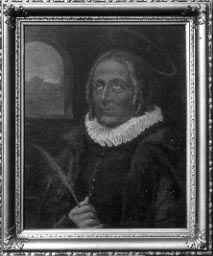 In 1999 a new stained glass window was unveiled in Worcester Cathedral.
A section of the window depicts John Wall.
In 1999 a new stained glass window was unveiled in Worcester Cathedral.
A section of the window depicts John Wall.


 In 1999 a new stained glass window was unveiled in Worcester Cathedral.
A section of the window depicts John Wall.
In 1999 a new stained glass window was unveiled in Worcester Cathedral.
A section of the window depicts John Wall.
Born in 1620 at Chingle Hall, Preston, his well to do family came from Norfolk. They had moved to Lancashire because of the diligent persecution of Catholics in the Norfolk area. Persecution in Lancashire was much less because of the very extensive Catholic population.
When John Wall was old enough to leave home he elected to go to The English College at Douai, France. (In the 1890s Douai closed and moved to Reading, Berkshire.) In 1641 he moved to Rome and was ordained priest. His brother, William, was to follow in his footsteps and become a priest a few years later.
It was in 1648 that he set out for England as a pilgrim. He called at Douai and visited the Franciscan Convent of St.Bonaventure, a visit that was to prove important to him. He travelled on to England where he made a brief visit returning to Douai and to the Convent of St.Bonaventure. Here he was clothed as a Franciscan, the Order of Friars Minor. His scholarship was such that two years later he was Instructor of Novices and Juniors. “His superiors observe the fair progress he had made in sanctity and learning judged him fully ripe and completely qualified for the Mission.” He was commanded for England and arrived in 1656. Shortly afterwards his brother, William, was to follow him and become a Benedictine working in London.
John Wall worked in Mission England for 23 years. He cared for Catholics in the Broom, Wixford, Grafton, Eversley and Coughton areas of Warwickshire. “It is well known that he feared none but God - a baronet was no more to him than a beggar.” He also ministered to Protestants and secretaries that were sick. He travelled first throughout Warwickshire, Worcestershire and Staffordshire. “His preaching was not to tickle the ear but to wound the heart.”
 In 1667 he took up residence at Harvington Hall, near Chaddesley
Corbett. It was here that he settled under the benefice of Lady Margaret
Yate, who was related to the Pakington and Throckmorton families. At
that time the Throckmorton’s owned Harvington Hall.
In 1667 he took up residence at Harvington Hall, near Chaddesley
Corbett. It was here that he settled under the benefice of Lady Margaret
Yate, who was related to the Pakington and Throckmorton families. At
that time the Throckmorton’s owned Harvington Hall.
Here for 12 years he ministered to Catholics in the area. Harvington Hall had been prepared with secret hides by Nicholas Owen, the great creator of secret places.
Rushock Court, some 5 miles from Harvington Hall, was the place of his arrest. In 1678 the whole country was thrown into turmoil by the Titus Oates’ plot to assassinate the King. A mode of prejudice and hatred of the Catholic religion swept the country and it was in this ferment that John Wall was captured.
He was paraded before Sir John Pakington, a cousin of Lady Yate, at Westwood Park. When confronted with the oath of allegiance he declined to take it but declared that he was a faithful subject of the King. Thus he signed his own death warrant. On the 25th August 1679 John Wall was hung, drawn and quartered at Redhill, Worcester with two malefactors.
“The two malefactors being first executed our Innocent sufferer kissed the ladder of the gallows, ascended, gave a long and learned speech, or rather his own funeral sermon, which was honoured with plaudits and tears of the numerous assembly. John Wall kissed the hangman's hand and gave him ten shillings and with cheerful countenance he gave up his life.”
John Wall was canonised a Saint in 1970

Can you create more words or pictures for this or another page? You don't have to be an expert. Borrow a book from the library to get the basics of your subject , but write in your own words and add a little something to make it special. 100-300 words would be enough for your first piece: this short note is more than 100. You can always add more later! Any photo you took or has been in your family for years is a possibility. Is there something distinctively local about it - not necessarily the place, but perhaps the people, what they are wearing or doing? Send it by email to whe@freeuk.com, or by post to Worcester Writers' Circle c/o Worcester Library, Foregate Street, Worcester WR1 1DT.